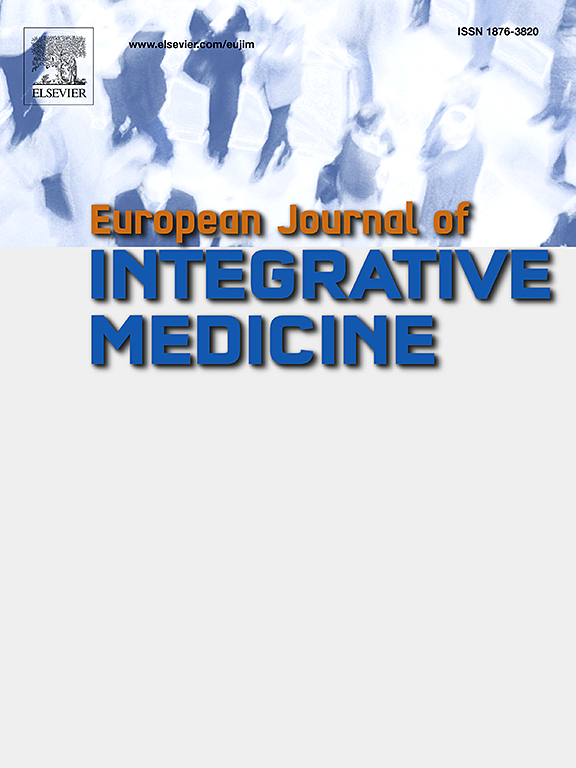不同中医证候致痛风的临床特点及预测因素分析:横断面研究
IF 1.7
4区 医学
Q3 INTEGRATIVE & COMPLEMENTARY MEDICINE
引用次数: 0
摘要
前言本研究旨在分析不同中医证候所致痛风患者的临床特点及预测因素。方法选取2019年至2022年1月在成都医学院第一附属医院就诊的痛风患者1658例。痛风患者主要分为湿热阻证(ODHS)、痰瘀证(IPBSS)、脾虚湿证(PDIDS)和气血虚证(QBDS) 4个亚型。最小绝对收缩和选择算子(LASSO)回归用于识别有助于中医证候分类的生物标志物,并使用受试者工作特征(ROC)曲线来评估模型的预测价值。决策曲线分析(DCA)曲线用于临床和柱线模型的视觉风险预测。结果不同中医证型痛风患者的rbc、HGB、LY、HCT、MCHC、TP、ALB、BUN、CREA、尿酸、CysC、LDL-C、LP-A、Hcy、年龄差异有统计学意义(P <;0.05)。PDIDS组、QBDS组、ODHS组、IPBSS组的auc (95%CI)分别为0.546(0.493,0.598)、0.624(0.565,0.682)、0.569(0.518,0.621)、0.559(0.480,0.637)。结论本研究在痛风患者临床实验指标的基础上,建立了四种中医证型预测模型。这些模型为后续阶段进一步研究痛风中医证候机制及临床诊疗提供了基础。本文章由计算机程序翻译,如有差异,请以英文原文为准。
Analysis of clinical characteristics and predictive factors in patients with gout caused by different traditional Chinese medicine syndromes: A cross-sectional study
Introduction
This study aimed to analyse the clinical characteristics and predictive factors of patients with gout caused by different traditional Chinese medicine syndromes.
Methods
A total of 1658 patients with gout who visited the First Affiliated Hospital of Chengdu Medical College between 2019 and January 2022 were included in this study. The patients with gout were primarily categorized into four subtypes, namely, patients with obstruction of dampness and heat syndrome (ODHS), patients with intermingled phlegm blood stasis syndrome (IPBSS), patients with Pi (Spleen)-deficiency induced dampness syndrome (PDIDS), and patients with qi-blood deficiency syndrome (QBDS). Least absolute shrinkage and selection operator (LASSO) regression was used to identify biomarkers that contribute to the TCM syndrome classification, and receiver operating characteristic (ROC) curves were used to evaluate the predictive value of the model. Decision curve analysis (DCA) curves were employed for visual risk prediction of the clinical and column line models.
Results
RBC, HGB, LY, HCT, MCHC, TP, ALB, BUN, CREA, URIC, CysC, LDL-C, LP-A, Hcy, and age of patients with gout differed significantly among the different TCM syndrome types (P < 0.05). The AUCs(95%CI) of the PDIDS, QBDS, ODHS, and IPBSS groups in the training set were: 0.546 (0.493, 0.598), 0.624 (0.565, 0.682), 0.569 (0.518, 0.621), and 0.559 (0.480, 0.637), respectively.
Conclusion
On the basis of the clinical experimental indicators of patients with gout, this study established four prediction models of TCM syndrome types. These models provide a basis for further research into the mechanism underlying TCM syndrome and the clinical diagnosis and treatment of gout in the subsequent stage.
求助全文
通过发布文献求助,成功后即可免费获取论文全文。
去求助
来源期刊

European Journal of Integrative Medicine
INTEGRATIVE & COMPLEMENTARY MEDICINE-
CiteScore
4.70
自引率
4.00%
发文量
102
审稿时长
33 days
期刊介绍:
The European Journal of Integrative Medicine (EuJIM) considers manuscripts from a wide range of complementary and integrative health care disciplines, with a particular focus on whole systems approaches, public health, self management and traditional medical systems. The journal strives to connect conventional medicine and evidence based complementary medicine. We encourage submissions reporting research with relevance for integrative clinical practice and interprofessional education.
EuJIM aims to be of interest to both conventional and integrative audiences, including healthcare practitioners, researchers, health care organisations, educationalists, and all those who seek objective and critical information on integrative medicine. To achieve this aim EuJIM provides an innovative international and interdisciplinary platform linking researchers and clinicians.
The journal focuses primarily on original research articles including systematic reviews, randomized controlled trials, other clinical studies, qualitative, observational and epidemiological studies. In addition we welcome short reviews, opinion articles and contributions relating to health services and policy, health economics and psychology.
 求助内容:
求助内容: 应助结果提醒方式:
应助结果提醒方式:


